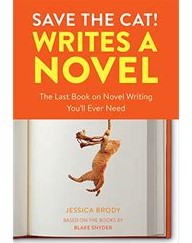 I’ve been writing for a very long time, but only recently was I introduced to a wonderful book about writing called Save the Cat! Writes a Novel by Jessica Brody.
I’ve been writing for a very long time, but only recently was I introduced to a wonderful book about writing called Save the Cat! Writes a Novel by Jessica Brody.
For anyone who doesn’t know (I assumed I was the last one), this guide is based on screenwriter Blake Snyder’s popular 2005 book called Save the Cat! The Last Book on Screenwriting You’ll Ever Need. In a nutshell, Snyder’s book became an instant classic when it was used by screenwriters, directors, producers—pretty much everyone involved in developing a film—to create a story that was tighter, more compelling, and, importantly, successful.
 By back-engineering popular films, Blake was able to identify fifteen common “beats”—plot points that characterized a well-told story. In Save the Cat! (as it’s called by those in the know), he organizes these beats into a three-part framework that writers can use to create a better structure for their story. A few years later, when Brody (an ex-movie studio executive) was struggling to get her novel published amidst a slew of rejection letters, a friend suggested she take a look at Blake’s book and see if the same process could work for writing a novel. The happy conclusion was that it could, and since that time, Brody has sold more than fifteen books to major publishers. One of those books was Save the Cat! Writes a Novel.
By back-engineering popular films, Blake was able to identify fifteen common “beats”—plot points that characterized a well-told story. In Save the Cat! (as it’s called by those in the know), he organizes these beats into a three-part framework that writers can use to create a better structure for their story. A few years later, when Brody (an ex-movie studio executive) was struggling to get her novel published amidst a slew of rejection letters, a friend suggested she take a look at Blake’s book and see if the same process could work for writing a novel. The happy conclusion was that it could, and since that time, Brody has sold more than fifteen books to major publishers. One of those books was Save the Cat! Writes a Novel.
As Brody writes in her book’s introduction, “Is this a coincidence? Definitely not. Am I just that good of a writer? Debatable. Did Blake Snyder invent something that no one ever had before? Not at all. He simply studied the elements of story and character transformation and noticed an underlying pattern. A secret storytelling code.”
Is this a coincidence? Definitely not. Am I just that good of a writer? Debatable. Did Blake Snyder invent something that no one ever had before? Not at all. He simply studied the elements of story and character transformation and noticed an underlying pattern. A secret storytelling code.”
As Brody is quick to point out, however, there is no magic here. The things you learned in elementary school about what makes a good story still hold: every story needs a beginning, middle, and end; every story needs compelling characters; and every story needs tight, well-paced action.
Like its predecessor, Brody’s book employs the series of fifteen beats, but tweaked just a bit to be more compatible with novel writing. She makes the case that these beats are present in most successful books, and by using them as a framework to structure your story, you can avoid many of the pitfalls that editors continually enumerate in their rejection letters. Brody’s book offers a checklist of the beats and takes readers step-by-step through the process, with straightforward explanations and lots of examples to show how it’s done. Save the Cat! Writes a Novel is a book that serious writers will find themselves referring to again and again as they work at mastering their craft.
 Oh, and about the cat. One of Blake’s story-telling tips in the original Save the Cat! offered a way to deal with a main character who is coming across as rather churlish. You simply have him save a cat—you know, like from a tree or a burning building. Voila! Your hero has shown his humanity and endeared himself to millions of cat-lovers around the world. (As a dog person, I’m obligated to point out the fatal flaw in this tip—but I get the point.)
Oh, and about the cat. One of Blake’s story-telling tips in the original Save the Cat! offered a way to deal with a main character who is coming across as rather churlish. You simply have him save a cat—you know, like from a tree or a burning building. Voila! Your hero has shown his humanity and endeared himself to millions of cat-lovers around the world. (As a dog person, I’m obligated to point out the fatal flaw in this tip—but I get the point.)
Buy the book. It is, without a doubt, one of the best things you can do for your writing career. And good luck!